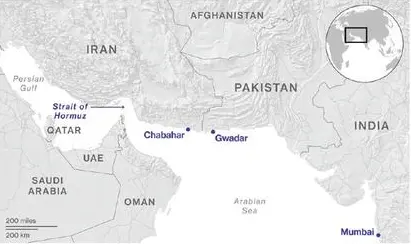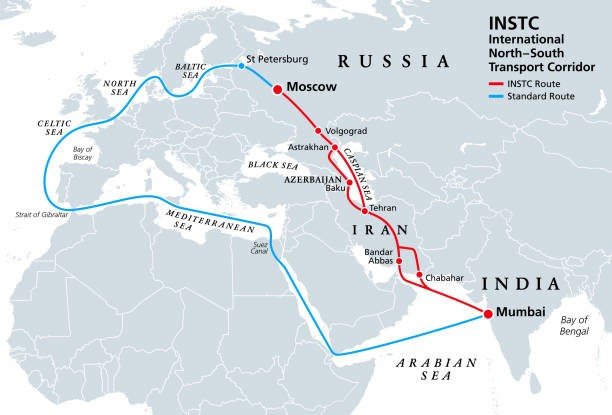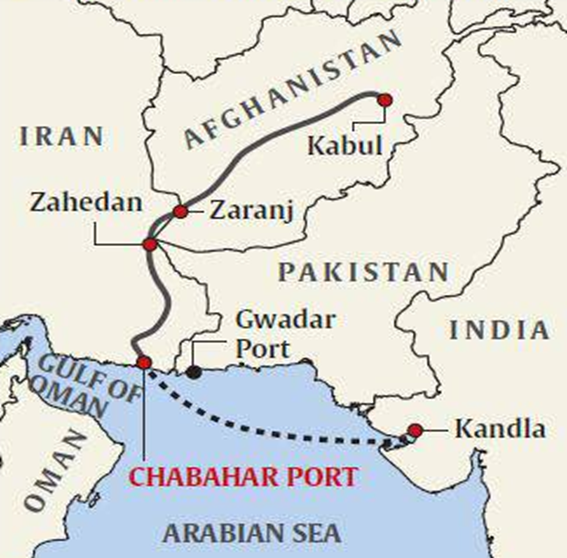Introduction
The new 10-year agreement between India and Iran to develop the Chabahar port carries the “potential risk” of sanctions, the U.S. State Department said, casting a cloud over whether the special exemption India had received from the U.S. in 2018 will still be applicable for the next phase of development and investments in the Iranian project.

Chabahar Port Agreement
- The India-Iran Chabahar Port Agreement is a strategic pact between India and Iran focused on the development and utilization of the Chabahar Port, located in southeastern Iran.
- The agreement aims to enhance trade and connectivity between the two nations and facilitate access to Afghanistan and Central Asia, bypassing Pakistan.
- India has committed to developing the Chabahar Port’s infrastructure, including the construction of berths and cargo handling facilities.
- This development is intended to make the port fully operational and capable of handling significant cargo volumes.
Read also: Get The Best UPSC GS Foundation 2 Year Course with Tarun IAS
Importance of Chabahar Port
- The Chabahar Port is located in southeastern Iran on the Gulf of Oman, near the border with Pakistan.
- It is Iran’s only oceanic port and offers direct access to the Indian Ocean, which makes it strategically significant for both Iran and regional players, particularly India.
- The importance of Chabahar Port under various headings is discussed below:
a) Strategic Location:
- Geopolitical Significance: Chabahar’s location outside the Persian Gulf reduces the dependency on the Strait of Hormuz, a critical chokepoint for global oil shipments that is often subject to geopolitical tensions. This enhances the security of trade routes.
- Proximity to Afghanistan and Central Asia: The port is situated closer to Afghanistan and Central Asia compared to other regional ports. This makes it a crucial hub for accessing these landlocked regions.
b) Economic and Trade Benefits:
- Trade Gateway: Chabahar Port provides a direct sea-land route for trade between India, Iran, Afghanistan, and Central Asia, bypassing Pakistan. This is especially beneficial for India, which faces logistical and political challenges in accessing Central Asia through Pakistan.
- Reduction in Trade Costs and Time: By offering a shorter and more efficient route, the port helps reduce the transportation time and costs of goods moving between these regions.
c) Regional Connectivity:
- International North-South Transport Corridor (INSTC): Chabahar is a critical component of the INSTC, a multi-modal network that connects India to Central Asia, Russia, and Europe through Iran. This corridor aims to facilitate smoother and faster trade flows.
- Development of Transportation Infrastructure: Investments in rail and road connectivity from Chabahar to Afghanistan and further into Central Asia are crucial for enhancing regional trade and economic integration.
International North South Transport Corridor (INSTC)
|
d) Geopolitical Counterbalance:
- Counter to Gwadar Port: Chabahar provides a strategic counterbalance to Pakistan’s Gwadar Port, which is developed with significant Chinese investment under the China-Pakistan Economic Corridor (CPEC). By developing Chabahar, India aims to offset China’s growing influence in the region.
- Strengthening Regional Partnerships: The port development strengthens India-Iran relations and supports India’s broader strategy of engaging with Central Asian countries and Afghanistan.
e) Support for Afghanistan:
- Economic Independence: For Afghanistan, Chabahar offers an alternative trade route that bypasses Pakistan, enhancing its economic independence and integration with global markets.
- Humanitarian and Development Aid: The port facilitates the flow of humanitarian aid and development projects to Afghanistan, contributing to its reconstruction and stability.
f) Economic Zones and Industrial Development:
- Special Economic Zones: The development of Special Economic Zones (SEZs) around Chabahar is intended to attract investment, promote industrialization, and boost economic activity in the region.
- Job Creation and Local Development: The port and associated infrastructure projects generate employment opportunities and contribute to local economic development in southeastern Iran.
In summary, Chabahar Port is a linchpin for regional trade and connectivity, providing strategic, economic, and geopolitical benefits to Iran, India, Afghanistan, and Central Asia. Its development fosters regional integration, economic growth, and stability while countering other regional powers’ influences.
Delaram-Zaranj Highway• In 2003, a trilateral agreement was signed among India, Iran and Afghanistan. • Under this agreement,
• Border Roads Organization (BRO) of India has constructed this highway. • Construction started in 2005, and in 2009 the road was opened for public use.
|
Challenges to Chabahar Project
- While the Chabahar Port project holds significant promise for enhancing regional connectivity and trade, several challenges impede its full realization. These challenges include:
a) Geopolitical Tensions:
- The project operates in a geopolitically sensitive region, with longstanding tensions between Iran, Pakistan, and other neighboring countries. Geopolitical rivalries and conflicts can affect the project’s stability and hinder cooperation between stakeholders.
b) Sanctions and International Relations:
- Iran has faced economic sanctions imposed by the United States and other countries, which have hindered foreign investment and financing for the Chabahar project. Additionally, fluctuations in Iran’s relations with key international players can impact the project’s progress and viability.
c) Infrastructure Development:
- Despite India’s commitments to develop the port infrastructure, progress has been slow due to challenges such as bureaucratic hurdles, funding constraints, and logistical complexities. Delays in infrastructure development can impede the port’s capacity to handle cargo and fulfill its potential as a trade gateway.
d) Security Concerns:
- The region surrounding Chabahar Port experiences security challenges, including piracy, insurgency, and smuggling activities. Ensuring the safety and security of maritime and land transportation routes is essential for the port’s operations and the success of associated trade corridors.
e) Connectivity and Logistics:
- The effectiveness of Chabahar Port as a trade route depends on efficient connectivity and logistics networks extending into Afghanistan and Central Asia. Inadequate transportation infrastructure, customs procedures, and border crossings can create bottlenecks and increase transit times and costs.
f) Competition from Gwadar Port:
- Pakistan’s Gwadar Port, developed in collaboration with China as part of the China-Pakistan Economic Corridor (CPEC), poses competition to Chabahar Port. Gwadar aims to serve as a key hub in China’s Belt and Road Initiative (BRI), potentially diverting trade away from Chabahar and impacting its economic viability.
g) Economic Viability and Trade Volume:
- The success of Chabahar Port depends on attracting sufficient trade volume to sustain its operations and generate revenue. Uncertainties regarding trade agreements, tariffs, and market demand can affect the port’s economic viability and attractiveness to investors.
Addressing these challenges requires sustained political will, diplomatic engagement, investment in infrastructure, security cooperation, and the establishment of conducive regulatory frameworks. Despite these obstacles, Chabahar Port remains a crucial component of regional connectivity efforts, with the potential to significantly enhance trade and economic integration in the broader South Asian and Central Asian regions.
Ashgabat Agreement
Do you know?
|
Read also: Kachchatheevu Island Dispute: Causes & Solutions | UPSC
Conclusion and the way forward
- Moving forward with the Chabahar Port project requires a comprehensive approach that addresses the challenges while capitalizing on the opportunities it presents. Here’s a suggested roadmap:
a) Enhanced Diplomatic Engagement:
- Engage in diplomatic efforts to build trust and foster cooperation among all stakeholders involved in the Chabahar project. This includes Iran, India, Afghanistan, and other regional partners. Multilateral forums can provide platforms for dialogue and consensus-building.
b) Security Cooperation:
- Collaborating on security measures to ensure the safety and security of the port and its transportation routes is essential. This may involve joint patrols, intelligence-sharing, and capacity-building initiatives to combat piracy, smuggling, and other security threats.
c) Infrastructure Development:
- Accelerating the development of port infrastructure, including berths, terminals, and transportation networks, is essential for increasing the port’s capacity and efficiency. This requires streamlining bureaucratic processes, expediting approvals, and implementing effective project management strategies.
d) Connectivity and Logistics:
- Improving transportation links and logistics networks connecting Chabahar Port to Afghanistan and Central Asia is critical. This involves investing in road, rail, and air infrastructure, as well as modernizing customs procedures and border crossings to facilitate trade flows.
e) Public-Private Partnerships:
- Leveraging public-private partnerships (PPPs) can help mobilize private sector expertise and resources for port development and operation. This can include concession agreements, build-operate-transfer (BOT) models, and other arrangements that share risks and rewards between the public and private sectors.
f) Trade Promotion and Economic Integration:
- Promoting trade and economic integration among the countries connected through Chabahar Port is crucial for its long-term success. This involves facilitating trade agreements, reducing trade barriers, and promoting economic cooperation and investment in the region.
By taking these steps, stakeholders can overcome the challenges facing the Chabahar Port project and unlock its potential as a key driver of regional trade, connectivity, and economic development. Effective coordination, cooperation, and commitment are essential to realizing this vision.
Mains Answer Writing Practice
Topic: Bilateral, Regional and Global Groupings and Agreements involving India and/or affecting India’s interests. (GS Mains Paper 2)
- In what ways does the India-Iran Chabahar Port Agreement impact regional geopolitics, trade dynamics, and India’s strategic interests, and what are the key challenges and opportunities associated with its implementation?
- In what ways does the India-Iran Chabahar Port Agreement contribute to India’s regional connectivity initiatives and strategic interests, considering its implications for trade, geopolitics, and economic development? (Answer in 250 words)
Model Answers:
References
- https://www.istockphoto.com/illustrations/bandar-abbas
- https://pib.gov.in/PressReleasePage.aspx?PRID=1846762
- https://www.thehindu.com/opinion/op-ed/bringing-eurasia-closer/article65706597.ece
- https://www.thehindubusinessline.com/opinion/chabahar-and-its-implications-for-india/article8645020.ece
- https://www.india-briefing.com/news/indias-export-opportunities-along-the-international-north-south-transport-corridor-22412.html/
- https://www.thehindu.com/opinion/op-ed/bringing-eurasia-closer/article65706597.ece
- https://indianexpress.com/article/explained/how-chabahar-port-could-bring-india-and-its-partners-iran-afghanistan-and-a-new-spring-4966443/
- https://indianexpress.com/article/explained/what-are-indias-stakes-in-irans-chabahar-port-9326692/
- https://www.thehindu.com/news/international/potential-risk-of-sanctions-for-any-business-deals-with-iran-says-us-in-wake-of-chabahar-port-deal/article68173579.ece



